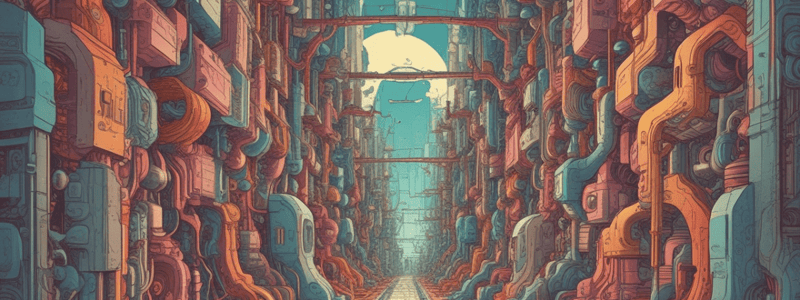Podcast
Questions and Answers
What is the main difference between object-oriented analysis and traditional analysis methodologies?
What is the main difference between object-oriented analysis and traditional analysis methodologies?
- Object-oriented analysis organizes requirements around objects, integrating data and functions, while traditional analysis considers functions and data separately. (correct)
- Object-oriented analysis excludes real world objects, while traditional analysis incorporates them.
- Object-oriented analysis focuses on high-level design, while traditional analysis focuses on low-level design.
- Object-oriented analysis uses procedural programming, while traditional analysis uses object-oriented programming.
How did Grady Booch define Object-Oriented Analysis (OOA)?
How did Grady Booch define Object-Oriented Analysis (OOA)?
- 'Object-oriented analysis is a method of analysis that examines requirements from the perspective of classes and objects in the problem domain.' (correct)
- 'Object-oriented analysis is a method of analysis that focuses solely on data in the problem domain.'
- 'Object-oriented analysis is a method of analysis that ignores objects and classes in the problem domain.'
- 'Object-oriented analysis is a method of analysis that looks at requirements from the perspective of software functions.'
What are the primary tasks involved in object-oriented analysis (OOA)?
What are the primary tasks involved in object-oriented analysis (OOA)?
- Identifying objects, creating object model diagram, defining object attributes, defining object actions, describing object interactions (correct)
- Creating flowcharts and sequence diagrams
- Writing code directly, testing the software, documenting user manuals
- Developing user interfaces, writing requirements documents, conducting market research
Which methodology examines requirements from the perspective of classes and objects?
Which methodology examines requirements from the perspective of classes and objects?
What are the common models used in Object-Oriented Analysis (OOA)?
What are the common models used in Object-Oriented Analysis (OOA)?
What does Object-Oriented Design (OOD) involve?
What does Object-Oriented Design (OOD) involve?
What is the main purpose of a system in UML?
What is the main purpose of a system in UML?
How is a model defined in the context of systems and models in UML?
How is a model defined in the context of systems and models in UML?
What is a view in the context of systems and models in UML?
What is a view in the context of systems and models in UML?
What is one of the major characteristics of Unified Process (UP)?
What is one of the major characteristics of Unified Process (UP)?
What is the Unified Process (UP) commonly known for?
What is the Unified Process (UP) commonly known for?
Why is the Unified Process (UP) considered flexible?
Why is the Unified Process (UP) considered flexible?
What is the main goal of the Inception phase in the described software development process?
What is the main goal of the Inception phase in the described software development process?
Which phase focuses on iterative implementation of the core architecture and resolution of high risks?
Which phase focuses on iterative implementation of the core architecture and resolution of high risks?
What is a key characteristic of the Waterfall Lifecycle model referenced in the text?
What is a key characteristic of the Waterfall Lifecycle model referenced in the text?
What is the purpose of the 'Integration and Testing' phase in the Waterfall model?
What is the purpose of the 'Integration and Testing' phase in the Waterfall model?
In the described software development process, what is the objective of the 'Transition' phase?
In the described software development process, what is the objective of the 'Transition' phase?
What distinguishes the Waterfall Lifecycle model from the iterative and incremental process described earlier?
What distinguishes the Waterfall Lifecycle model from the iterative and incremental process described earlier?
Which phase of the described software development process emphasizes capturing system requirements?
Which phase of the described software development process emphasizes capturing system requirements?
'Maintenance' in the Waterfall model involves:
'Maintenance' in the Waterfall model involves:
'Deployment of system' in the Waterfall Lifecycle model refers to:
'Deployment of system' in the Waterfall Lifecycle model refers to:
What is NOT a characteristic of an iterative and incremental development process?
What is NOT a characteristic of an iterative and incremental development process?
Flashcards are hidden until you start studying




